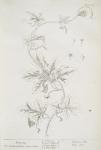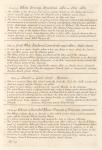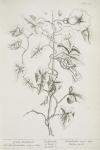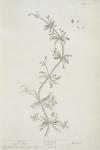

 37. White Briony. Bryonia alba or Vitis alba.
37. White Briony. Bryonia alba or Vitis alba.
1. The Stalks of this Briony climb up to a great Height in the Hedges; the Leaves much resemble those of a Vine; the Flowers are a whitish green Colour.
2. It grows in Lanes and Hedges, and flowers in May and Iune.
3. The Root is a strong Purger of serous watery Humours, which it does both upwards and downwards, & is esteemed good for ye Dropsy, Gout, Epilepsy, Palsy & hysteric Disorders. Doctor Sydenham commends it very much in cases of Madness. The Faecula is much of the same Nature, but something Weaker. The officinal Preparations are the Aqua Brioniae comp. or the Hysteric Water, and the Faecula Brioniae.
4. Greek, Άμπελος λευκή. Latin, Bryonia alba, or Vitis alba. Spanish, Neuxa, or Anorca. Italian, Brionia, or Zucca salvatica. French, Colubrine or Couluree. German, Strictwurk or Zeufelsturbss. Dutch, Wilde Wyngaarde.

 38. Great White Bindweed. Convolvulus major albus, or Smilax laevis.
38. Great White Bindweed. Convolvulus major albus, or Smilax laevis.
1. It runs up to a great height when it has any thing to twist about; the Leaves are a willow Green, and the Flowers white.
2. This Plant grows in most Hedges, and flowers all the latter end of the Summer.
3. The Root of the Great White Bindweed is somewhat cathartic. Prevotius in his Medicina Pauperum reckons it a gentle Evacuator of the Bile. Camerarius doubts whether this be the Smilax laevis of the Ancients.
4. Greek, Σμίλαζ λέια. Latin, Convolvulus major albus, or Smilax laevis. Spanish, Correquela major. Italian, Vilucchio maggiore. French, Liset or Campanetre. German, Binden. Dutch, Groote Winde.

 39. Clivers or Goose Grass. Aparine
39. Clivers or Goose Grass. Aparine
Also see #039, Clivers - #060, Wood-roof - #168, White Ladies-Bed-Straw.
1. This is a creeping Plant that grows annually from the Seed; the Stalks, Leaves and Seed are rough, and the Flowers are white.
2. It grows in most Hedges, and flowers for several Months in the Summer.
3. The whole Plant is used, & is esteemed moderately cooling & drying, good to sweeten ye Blood; It is also accounted vulnerary, & of Service in ye Kings-Evil, for which some give the Juice as a great Secret. It is likewise diuretic, and helps the Stone and Gravel. This is one of those Herbs which are commonly put into Spring Porridge as good for the Scurvy.
4. Greek, Απαρίνη. Latin, Aparine. Spanish, -. Italian, Aparine, or Speronella. French, -. German, Klebcraut. Dutch, Kleef-kruyd.

 40. Wheat, & Bearded Wheat. Triticum, & Triticum aristatum.
40. Wheat, & Bearded Wheat. Triticum, & Triticum aristatum.
1. The Wheat without Awns or Beards is that which grows most common in England; some call the Bearded Wheat Dugdale Wheat.
2. It is sown commonly in Autumn and reaped the Iuly or Augyst following.
3. This Grain is reckon'd more nourishing than any other Grain for Bread. A Poultice made of it boiled in Milk eases Pains, and ripens Tumours & Imposthumations. A piece of Bread, toasted and dip'd in Wine, is good to stop Vomiting, by applying it to the Stomach. The Bran is used in Cataplasms, and applied hot in Bags for Pains in the Sides. There was formerly kept in the Shops an Emplastrum de Crusta Panis.
4. Greek, Πυρός. Latin, Triticum or Triticum aristatum. Spanish, Trigo. Italian, Grano or Tormento. French, Fourment. German, Beissen. Dutch, Tarraw.

